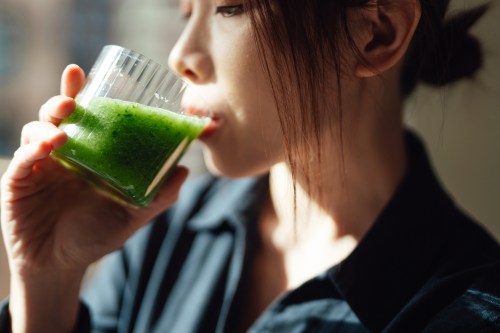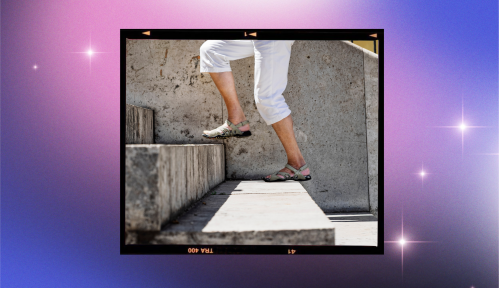6 Reasons Gut Health Experts Say Your Poop Might Be Green
Starting with your fave foods and drinks.

We get it: talking about your poop probably isn't on your list of favorite things to do. But noticing changes in your poop's color, texture, or shape can actually give you important clues about your gut health. One common concern? Green poop. Yep, it happens, but while it might catch you off guard, it's not always a reason to panic.
Experts in This Article
gastroenterologist, nutrition and lifestyle medicine specialist, and founder of Sarah Robbins MD
If you've ever wondered, "Why is my poop green?," you've come to the right place. We spoke with a board-certified gastroenterologist to fill us in on what green poop could mean, how to prevent and treat it, and when it might be worth checking in with your healthcare provider. From diet to digestion speed, there are many reasons your poop might take on a greenish hue, and understanding the cause can help you take better care of your gut health.
Why your poop changes color
While poop is typically brown thanks to a substance called bile pigments (a byproduct of digestion produced in the liver), many different factors can affect the color of your poop, including what you ate that day, changes to your gut transit time (i.e., how quickly waste moves through your digestive system), bile production, infections, or underlying medical conditions, says Sarah Robbins, MD, a gastroenterologist and health consultant based in Calgary, Canada.1,2,3
Here are some of the most common poop colors and what they mean, according to Dr. Robbins:
- Red poop can happen when you eat large amounts of foods with red pigments in them—like beets, cherries, or foods containing red food dye. However, consistently having red poop could indicate bleeding in your lower gastrointestinal (GI) tract, which can be caused by conditions like hemorrhoids (when veins in or around your anus become swollen), diverticulosis (when abnormal pouches form in the intestinal wall), and colorectal cancer, says Dr. Robbins. If red poop is a common fixture in your bathroom habits, it's important to let your provider know.
- Black poop is commonly caused by supplements and medications (like iron supplements and Pepto-Bismol), and can also happen when you eat dark-colored foods. However, having poop that is black, sticky, or tarry (known as melena) could indicate bleeding in your upper GI tract—due to conditions like ulcers or swollen veins in your esophagus.4 Dr. Robbins notes that in her practice, having melena is a concerning symptom and warrants further investigation.
- Pale or clay colored poop indicates the bile isn't flowing properly, which is common with conditions like liver disease, bile duct obstruction (when the flow of bile gets stopped up), or pancreatitis (inflammation of the pancreas).5 Like red and black poop, pale or clay colored poop is often an indication of a more serious underlying condition and should prompt a trip to your healthcare provider, says Dr. Robbins.
- Yellow poop can be caused by a variety of things, including fat malabsorption (i.e., your gut not digesting fats properly), liver or gallbladder issues, infections (like Giardia and norovirus), certain foods, or rapid transit of waste through your digestive tract, says Dr. Robbins.6
6 reasons for green poop
"Green stool can occur for a variety of reasons, and is often related to how bile is processed in the digestive system, the speed of digestion, and what you eat," explains Dr. Robbins. She adds that if this process is rapid, your poop may appear green.
With that, here are six of the most common reasons for green poop.
1. It's something you ate
If your poop is green, take a look at what you recently ate for clues about why that might be. "Consuming large amounts of chlorophyll-rich foods (i.e., the green pigment in many plants) such as spinach, kale, or other dark leafy greens can naturally tint stool green," Dr. Robbins says. She adds that foods and beverages containing green food dye—like some popsicles, candies, or sports drinks—may pass through the digestive system without being fully broken down and result in green poop.
2. You have an infection
Certain bacterial infections like Salmonella, Giardia, or Clostridiodes difficile (aka C. diff, previously known as Clostridium difficile), and viral infections like norovirus, can irritate the GI tract and result in diarrhea and increased gut motility, meaning food and waste move through the intestines more quickly, Dr. Robbins explains.
"When stool moves rapidly through the small and large intestines, bile doesn't have enough time to be fully broken down and reabsorbed," says Dr. Robbins. As a result, bile pigments remain yellow or greenish, and your poop takes on a yellow or greenish hue.
3. You might have a GI condition
Certain GI conditions can also cause stool to move quickly through your gut, resulting in its greenish-yellow appearance. This includes irritable bowel syndrome (IBS), which causes alternating patterns of diarrhea and constipation and is often characterized by increased gut sensitivity and rapid bowel movements.
On the other hand, inflammatory bowel diseases (IBD), like Crohn's disease or ulcerative colitis, can cause chronic gut inflammation that disrupts the absorption of key nutrients and bile, says Dr. Robbins, which can lead to green stool, too.
Another condition that can cause green poop is called bile acid malabsorption, Dr. Robbins adds. This condition, which is often seen in people who've had their gallbladder removed, happens when the body does not properly digest bile acids in the small intestine, so they end up in the large intestine instead. Watery or green-tinged poop can occur as a result—although yellow poop is more commonly seen with bile acid malabsorption.
4. It's a medication or supplement side effect
Sometimes, taking certain iron supplements can give your stool a dark green or blackish appearance, says Dr. Robbins. Antibiotics (i.e., medications that help fight off infections) can also disrupt the balance of bacteria in your gut microbiome and occasionally lead to diarrhea or altered poop color. Dr. Robbins also says that laxatives (or medications that speed up intestinal transit) can prevent bile from being fully processed, causing green-hued poop.
5. You just had surgery
Sometimes, undergoing certain types of surgery can change the consistency and color of your stool. Bowel surgery or gallbladder removal, for example, can lead to stool moving more quickly through the gut, giving it a yellow or greenish color from unprocessed bile, says Dr. Robbins. So, if you notice any stool changes after surgery, be sure to mention them to your healthcare provider at your post-op appointments.
6. You're under stress
Yes, you read that right: Stress can cause your poop to change color. "Periods of significant stress can alter digestion," says Dr. Robbins. That's because "high-stress situations or illnesses can stimulate the gut-brain axis (i.e., the nerve communication between your brain and stomach), leading to faster intestinal movement and altered stool appearance." So, the next time you notice green poop, check in with your stress levels to see if they could be the cause.
How to treat and prevent green poop
According to Dr. Robbins, the treatment or prevention strategy for green poop will depend on the underlying cause. "In most cases, green stool is benign and temporary, especially when linked to diet or minor disruptions in digestion," she adds.
That said, if you're trying to get your stool color back to baseline, here are some strategies and lifestyle tweaks you can try.
1. Make some diet adjustments
Because one of the most common causes of green poop is diet, keeping a simple food and symptom journal to identify potential causes can be helpful. Once you've found the potential cause—like foods containing green food dye, for example—consider temporarily reducing or eliminating those suspected foods to see if your poop color goes back to what's normal for you.
Another tip to keep in mind: Pay attention to food labeling when looking for the culprit, says Dr. Robbins. "Many 'natural' supplements or detox drinks contain plant-based dyes or chlorophyll that may contribute to stool color changes," she adds.
2. Add probiotics and prebiotics to support your microbiome
"A healthy gut microbiome (i.e., the balance of good and bad bacteria in the gut) plays a critical role in the breakdown and metabolism of bile acids, which are responsible for the brown color of normal stool," says Dr. Robbins. She adds that when this microbiome is disrupted by things like antibiotics, infections, diet, or stress, it can impair bile acid digestion and gut movement, potentially resulting in green stool.
The solution? Try taking probiotic supplements or eating more probiotic-rich foods, like yogurt, kefir, or kimchi, to help rebalance your gut microbiome. This good bacteria is especially helpful if you've recently had an infection or taken antibiotics that threw off your stomach, per Dr. Robbins. She recommends adding a high-quality probiotic for 4 to 8 weeks after taking antibiotics or recovering from an illness, to help restore your gut microbiome.7
Additionally, prebiotics—the non-digestible fibers that feed good bacteria in the gut—also support microbiome health and gut function over time, says Dr. Robbins. Because of this, she recommends adding more prebiotic-rich foods to your diet, like oats, bananas, leeks, garlic, and beans.
3. Manage stress (and learn about the gut-brain connection)
As we've learned, the gut-brain axis plays a big part in the state of your bowels. That's because "the gut and brain are closely connected through the enteric nervous system (i.e., the network of nerves in the gut) and vagus nerve (i.e., the longest cranial nerve in the body)," says Dr. Robbins.8
Because the mind and stomach are so connected, it's important to manage your stress to help tamp down stress-related gut symptoms like diarrhea or green-tinged stool. To do this, Dr. Robbins recommends stress-reduction techniques like deep breathing, yoga, meditation, or cognitive behavioral therapy (CBT).
Dr. Robbins says lifestyle habits like quality sleep, regular physical activity, and consistent meal patterns are important for both mental and gut health. And lastly, if home remedies do not help, she suggests asking your healthcare provider about mind-body therapies or gut-directed hypnotherapy, both of which have evidence in IBS and stress-sensitive gut disorders.9
4. Treat any underlying medical conditions
If you've tried the above strategies and your poop is still coming out green, it could be a sign of an underlying GI condition or infection that needs targeted treatment, says Dr. Robbins.
Here are a few treatments that may help get your poop back to it's typical brown color:
- Antibiotics or antiparasitic agents to treat bacterial or parasitic infections.10
- Bile acid binders (such as cholestyramine), to treat bile acid malabsorption.11
- Targeted medications to treat inflammatory bowel disease.
- Dietary changes to treat diarrhea resulting from gallbladder removal.
- Diagnostic tests such as stool cultures, ova and parasite tests, fecal calprotectin (a test to check for inflammation in your intestines), or endoscopic imaging (a test that uses a camera to see the inside of your GI tract) may be necessary to determine the root cause.
When to see a healthcare provider
Although green poop is typically nothing to be concerned about, Dr. Robbins recommends checking in with your provider if you're also experiencing any of the following symptoms:
- Persistent green poop lasting longer than 2 to 4 weeks.
- Greasy, foul-smelling poop that's accompanied by unintentional weight loss (which suggests fat malabsorption).
- Green poop that's accompanied by jaundice (yellow skin), dark urine, or pale/clay-colored stools (which suggests liver or bile duct disease).
- Green poop that's accompanied by severed abdominal pain, vomiting, or other systemic symptoms like fever.
- Profuse watery diarrhea, reduced urine output, or dehydration.
Ultimately, it's important to remember that most of the time, green poop is nothing to worry about. "As a gastroenterologist, I'm rarely concerned about green stool because in most cases, it's diet-related or due to benign changes in gut motility rather than a serious underlying disease," Dr. Robbins says.
So, before you panic, think back to your last salad—or that green sports drink you chugged after a workout. Leafy greens and food dye are often the real culprits behind green poop!
- “Bile Pigment.” Bile Pigment - an Overview | ScienceDirect Topics, www.sciencedirect.com/topics/medicine-and-dentistry/bile-pigment. Accessed 23 Apr. 2025.
↩︎ - “Intestine Transit Time.” Intestine Transit Time - an Overview | ScienceDirect Topics, www.sciencedirect.com/topics/biochemistry-genetics-and-molecular-biology/intestine-transit-time. Accessed 23 Apr. 2025.
↩︎ - Hundt M, Basit H, John S. Physiology, Bile Secretion. [Updated 2022 Sep 26]. In: StatPearls [Internet]. Treasure Island (FL): StatPearls Publishing; 2025 Jan-. Available from: https://www.ncbi.nlm.nih.gov/books/NBK470209/ ↩︎
- “Melena.” Melena - an Overview | ScienceDirect Topics, www.sciencedirect.com/topics/pharmacology-toxicology-and-pharmaceutical-science/melena. Accessed 23 Apr. 2025.
↩︎ - Coucke EM, Akbar H, Kahloon A, et al. Biliary Obstruction. [Updated 2022 Nov 26]. In: StatPearls [Internet]. Treasure Island (FL): StatPearls Publishing; 2025 Jan-. Available from: https://www.ncbi.nlm.nih.gov/books/NBK539698/ ↩︎
- Zuvarox T, Belletieri C. Malabsorption Syndromes. [Updated 2023 Jul 24]. In: StatPearls [Internet]. Treasure Island (FL): StatPearls Publishing; 2025 Jan-. Available from: https://www.ncbi.nlm.nih.gov/books/NBK553106/ ↩︎
- Éliás, Anna Júlia et al. “Probiotic supplementation during antibiotic treatment is unjustified in maintaining the gut microbiome diversity: a systematic review and meta-analysis.” BMC medicine vol. 21,1 262. 19 Jul. 2023, doi:10.1186/s12916-023-02961-0 ↩︎
- Rao, M., Gershon, M. The bowel and beyond: the enteric nervous system in neurological disorders. Nat Rev Gastroenterol Hepatol 13, 517–528 (2016). https://doi.org/10.1038/nrgastro.2016.107 ↩︎
- Peters, S. L., et al. “Randomised clinical trial: The efficacy of gut‐directed hypnotherapy is similar to that of the low fodmap diet for the treatment of irritable bowel syndrome.” Alimentary Pharmacology & Therapeutics, vol. 44, no. 5, 11 July 2016, pp. 447–459, https://doi.org/10.1111/apt.13706.
↩︎ - Campbell S, Soman-Faulkner K. Antiparasitic Drugs. [Updated 2023 May 29]. In: StatPearls [Internet]. Treasure Island (FL): StatPearls Publishing; 2025 Jan-. Available from: https://www.ncbi.nlm.nih.gov/books/NBK544251/ ↩︎
- Riaz S, John S. Cholestyramine Resin. [Updated 2023 May 8]. In: StatPearls [Internet]. Treasure Island (FL): StatPearls Publishing; 2025 Jan-. Available from: https://www.ncbi.nlm.nih.gov/books/NBK534089/ ↩︎
Sign Up for Our Daily Newsletter
Get all the latest in wellness, trends, food, fitness, beauty, and more delivered right to your inbox.
Got it, you've been added to our email list.










